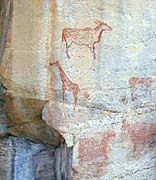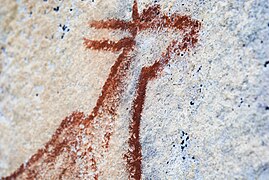Tsodilo hill
| Tsodilo | |
|---|---|
|
UNESCO world heritage |
|

|
|
| National territory: |
|
| Type: | Culture |
| Criteria : | i, iii, vi |
| Surface: | 4,800 ha |
| Buffer zone: | 70,400 ha |
| Reference No .: | 1021 |
| UNESCO region : | Africa |
| History of enrollment | |
| Enrollment: | 2001 (session 25) |
The Tsodilo Hills (English: Tsodilo Hills ) are a range of hills in the north of the Kalahari in the North West District of Botswana , about 53 kilometers southwest of Shakawe . In 1997 the hills and their surroundings were included in the UNESCO World Heritage List as a World Heritage Site .
description
In contrast to the nearby wetland of the Okavango Delta , the landscape here is dry and desert-like. The hills, rising to a height of 1489 m, consist of four massive rocks made of quartzite , which slope steeply to the desert at the sides. They form one of the largest elevations in Botswana.
Parts of the Hambukushu and San peoples live here . They created more than 4,500 rock art , which makes Tsodilo one of the sites with the highest density of rock art in the world and is known as the Louvre of the desert . Some of the paintings date from the 8th to 13th centuries . The place is sacred to the locals as a place where the spirits of the ancestors dwell.
A legend of the San says that the largest of the four rocks is the "man", the smaller the "woman", and the smallest the "child". The fourth rock is again the man's first wife whom he left for a younger woman.
World Heritage
In 2001, the Tsodilo Hills were entered on the UNESCO World Heritage List as a cultural heritage site under the name Tsodilo, based on a decision of the 25th session of the World Heritage Committee.
The brief description of the site states, among other things:
“(Ii): The hills have provided shelter and other resources to people for over 100,000 years. The site now retains a remarkable trace of not only this use, but also the development of human culture and a symbiotic relationship between nature and man over many thousands of years in its archeology, rock art and enduring traditions. "
The entry was made on the basis of criteria (i), (iii) and (vi).
“(Ii): For thousands of years the rocky foothills of Tsodilo in the rough landscape of the Kalahari desert have been visited and settled by people who have left rich traces of their presence in the form of outstanding rock art.
(ii): Tsodilo is a site that has seen visits and settlements by successive human communities over many millennia.
(ii): The Tsodilo foothills have immense symbolic and religious significance for the human communities that continue to survive in this hostile environment. "
The reserve includes the range of hills with their immediate surroundings. It has an area of 4,800 ha and is surrounded by a buffer zone with an area of 70,400 ha.
gallery
Web links
Individual evidence
- ↑ a b c d e Tsodilo. In: whc.unesco.org. UNESCO World Heritage Center, accessed June 23, 2017 .
- ↑ Decision: CONF 208 XA In: whc.unesco.org. UNESCO World Heritage Center, accessed June 23, 2017 .
Coordinates: 18 ° 45 ′ 45.7 ″ S , 21 ° 44 ′ 55 ″ O





